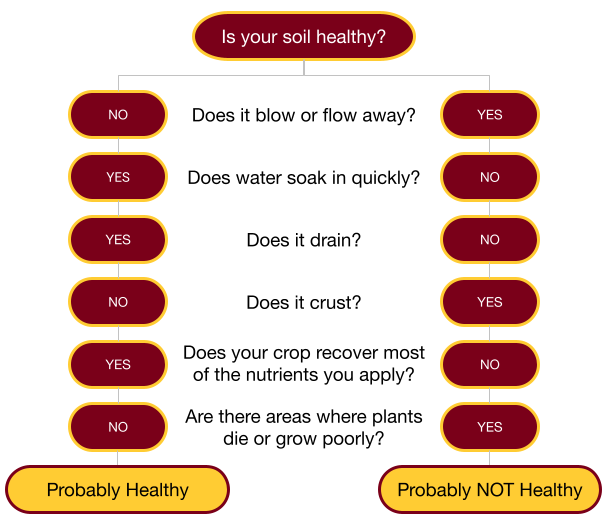Soil is physical, chemical and biological
Soil is not a static pile of broken down rock, but a dynamic, interacting mix of mineral particles, air, water, and organic matter. The organic matter is a diverse mix of plant, animal and microbial debris.
Soil is often described in terms of its physical texture, or how much sand, silt and clay particles are present in the mineral portion. The physical texture is based on geologic deposits of the region as well as climate and weathering processes. Soil is also described in terms of its chemical properties like pH and concentrations of inorganic nitrate and phosphorus, which are important for plant growth. These properties are dependent on the texture and climate but also respond to the land use. Biological properties of the soil are the most difficult to measure and describe. The percent organic matter is commonly reported on soil tests. The amount of organic matter indicates how much food and shelter is available for microbes and invertebrates, but it doesn’t indicate which organisms are present, or how abundant, diverse, or active they are. As these microbes and invertebrates feed, reproduce, and excrete waste, they mineralize nutrients that plants depend on and create soil structure which leaves room for water and air in the soil. See this UMN Extension/NDSU bulletin about soil organic matter for more details about Why Organic Matter Matters.
Soil health is soil function
The USDA Natural Resources Conservation Service (NRCS) defines soil health as the soil’s ability to function as a vital, living ecosystem. The key word is “function”, and when assessing soil health it’s valuable to start by considering what functions are most important to your farm. Are you concerned about crop health and productivity? Healthy soil should support healthy plants. Are you concerned about holding water and nutrients? Healthy soil should let water flow in and store for future use. Are you concerned about keeping soil in place? Healthy soil should not blow or flow away.
Your definition of healthy soil depends on what functions you are most interested in. In many cases, there may be limiting factors, like salinity, coarse texture and low nutrient holding capacity, or a high water table, which will define your approach to soil health. Keep in mind that these functions are based on using soil to grow crops-- a natural area may not need to drain or cycle nutrients in the same way.

(Andy McGuire, Washington State)
Principles for building soil health
- Keep the soil covered.
- Minimize disturbance.
- Keep living roots in the ground.
- Diversify rotations.
- Integrate livestock.
Adopting these five principles will build soil by protecting it from erosion and providing a constant food source to the underground food web. The constant food source is important because microbes feed on residues and living root exudates, and in turn feed larger soil organisms. Microbes and roots also excrete organic matter which binds soil particles into stable soil aggregates. That’s why feeding the food web leads to porous soil which allows water to infiltrate and remain in the soil for longer. (Soil organic matter and soil water fact sheet)
Producers apply these principles in many different ways. For Minnesota row crop farmers, it commonly means reducing tillage and incorporating a winter cover crop. See the Management page for more details. For another look at how the principles work, see Menoken Farm, a North Dakota demonstration site devoted to promoting soil health.